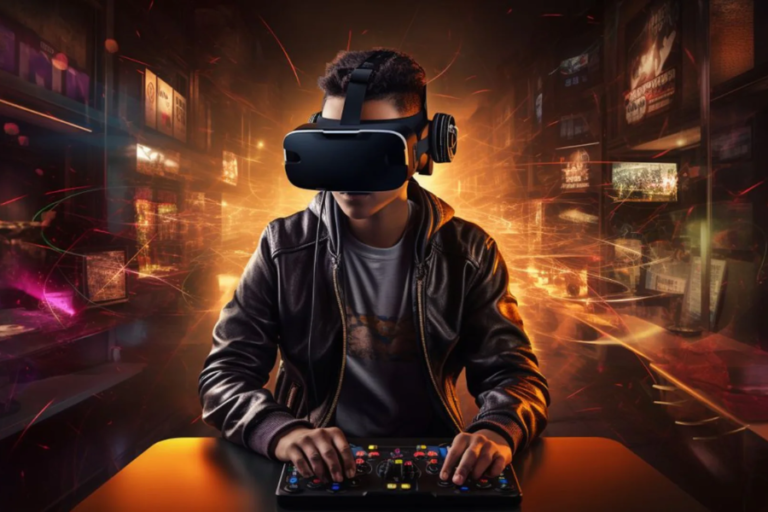Exploring VHSGJQM: A Deep Dive into the Latest Technological Trends
Introduction
Technology is a field that is always changing, with new developments appearing at a rapid rate. In order to be innovative and competitive, businesses and people need to stay up to date with these developments. Though it may not seem familiar, the VHSGJQM framework captures the key themes that are now reshaping the technology industry. This article examines VHSGJQM with a particular focus on the ways in which the world is changing due to technological advancements including blockchain, AI, IoT, cybersecurity, sustainable technology, and remote work. To determine what these patterns signify for the future, we’ll examine their advantages, uses, and potential consequences.
Understanding VHSGJQM
VHSGJQM stands for a strategic model that integrates multiple technological trends aimed at boosting efficiency and innovation across different sectors. While the term itself may not be widely recognized, it encompasses essential advancements transforming industries and everyday life. Think of VHSGJQM as an overarching approach that combines several tech-driven strategies to foster growth and adaptability in a dynamic world.
The Rise of Artificial Intelligence
Understanding AI and Its Applications
Artificial Intelligence (AI) is now a vital tool across many industries, surpassing its beginnings as a future idea. It makes it possible for robots to carry out operations like voice recognition, problem solving, and decision making that normally demand for human intellect. AI is frequently utilized in enterprises to increase productivity and automate tedious jobs, freeing up staff members to concentrate on more important responsibilities.
Key Applications of AI
- Customer Service: AI-powered chatbots provide round-the-clock customer support, improving response times and customer satisfaction. These virtual assistants can handle routine inquiries, allowing human agents to focus on more complex issues.
- Healthcare: In healthcare, AI algorithms analyze vast amounts of medical data to assist in diagnosing diseases, predicting patient outcomes, and even developing personalized treatment plans.
- Finance: AI is used for fraud detection, risk management, and predictive analytics in financial services, helping institutions make data-driven decisions and improve security.
The Future of AI
The future of AI is promising, with continued advancements in natural language processing, deep learning, and machine learning. As AI technology evolves, it will become even more integrated into our daily lives, enhancing user experiences in everything from home automation to professional services.
Blockchain Technology: Revolutionizing Security and Transparency
What is Blockchain?
Blockchain is a digital ledger that is decentralized and ensures transparency by securely recording transactions across several computers. Though cryptocurrency like Bitcoin is where it is most well-known, its uses are far-reaching. Data integrity is ensured by blockchain technology, which makes it nearly hard to make changes to old information.
Applications of Blockchain
- Finance: Blockchain enables secure transactions in cryptocurrencies and peer-to-peer payment systems. It eliminates the need for intermediaries, reducing transaction costs and increasing speed.
- Supply Chain Management: By tracking products from their source to the end consumer, blockchain enhances transparency and accountability in supply chains.
- Healthcare: Patient records can be securely stored and shared using blockchain technology, ensuring that sensitive medical information is protected and accessible only to authorized parties.
The Future of Blockchain
As regulatory frameworks evolve and industries recognize blockchain’s potential, adoption will continue to grow. We can expect further innovation in areas such as decentralized finance (DeFi), smart contracts, and secure data-sharing platforms.
The Internet of Things (IoT): Connecting the World
Understanding IoT
The Internet of Things refers to the interconnected network of physical devices that communicate and share data with each other over the internet. This technology allows for the automation of various tasks and enables devices to work together seamlessly, making life more convenient and efficient.
Key Applications of IoT
- Smart Homes: IoT powers devices like smart thermostats, lighting systems, and security cameras, allowing homeowners to control and monitor their living spaces remotely.
- Wearable Technology: Fitness trackers and smartwatches collect health-related data, such as heart rate and activity levels, helping users make informed lifestyle choices.
- Industrial IoT: In manufacturing, IoT sensors monitor equipment performance in real time, optimizing production processes and predicting maintenance needs to reduce downtime.
The Future of IoT
The IoT market is expected to expand significantly, with more devices becoming connected. The next wave of IoT will likely focus on smarter, more efficient solutions for smart cities, autonomous vehicles, and industrial automation.
Cybersecurity: Safeguarding the Digital Frontier
The Importance of Cybersecurity
As technology becomes increasingly integrated into our lives, the risk of cyber threats continues to grow. Cybersecurity is critical for protecting sensitive information, preventing data breaches, and maintaining trust in digital interactions.
Key Cybersecurity Trends
- AI in Cybersecurity: AI is being utilized to detect and respond to cyber threats in real time, enhancing the ability of organizations to protect against malicious attacks.
- Zero Trust Architecture: This approach to security assumes that threats can come from both inside and outside the network, requiring continuous verification of users and devices.
- Data Privacy Regulations: Governments are implementing stricter regulations to protect consumer data, forcing businesses to comply with new standards.
The Future of Cybersecurity
As cyber threats become more sophisticated, companies must invest in advanced security measures and adopt proactive strategies to mitigate risks. This includes embracing emerging technologies like quantum computing and blockchain to further enhance data protection.
Sustainable Technology: A Shift Towards Eco-Friendly Solutions
The Growing Demand for Sustainability
With heightened awareness of environmental issues, sustainable technology has become a priority for businesses and consumers alike. The shift towards eco-friendly solutions aims to minimize environmental impact while maximizing operational efficiency.
Key Areas of Sustainable Technology
- Renewable Energy: Technologies such as solar, wind, and hydro power are gaining traction, as companies seek to reduce their carbon footprints and transition to cleaner energy sources.
- Sustainable Manufacturing: Businesses are adopting practices that reduce waste, use recycled materials, and minimize energy consumption during production.
- Green Transportation: Electric vehicles (EVs) and alternative fuels are becoming more popular, contributing to cleaner air and reduced greenhouse gas emissions.
The Future of Sustainable Technology
As sustainability becomes central to business strategies, we will see continued investment in green technologies. Companies that prioritize sustainability will not only help the planet but also enhance their brand reputation and attract eco-conscious consumers.
Remote Work Technology: Redefining the Modern Workplace
The Evolution of Remote Work
The COVID-19 pandemic accelerated the adoption of remote work, leading to a permanent shift in how businesses approach workforce management. As a result, new tools and technologies have emerged to support remote collaboration and productivity.
Key Technologies Supporting Remote Work
- Collaboration Tools: Platforms like Slack, Zoom, and Microsoft Teams facilitate communication and teamwork across distances, making it easier for remote teams to stay connected.
- Project Management Software: Tools such as Asana, Trello, and Monday.com help teams manage tasks, track progress, and meet deadlines efficiently.
- Cybersecurity Measures: With employees accessing corporate networks from various locations, businesses must implement robust security protocols to protect sensitive information.
The Future of Remote Work
As remote work becomes a long-term fixture for many organizations, technology will continue to evolve to meet the unique needs of distributed teams. This includes advancements in virtual reality (VR) for immersive remote meetings, AI-driven productivity tools, and enhanced cybersecurity measures.
Conclusion: Embracing the VHSGJQM Framework
The most important technological trends that are influencing the digital landscape of today are summed up in the VHSGJQM framework. From computer based intelligence and blockchain to IoT and manageable innovation, these progressions are driving development, further developing effectiveness, and changing enterprises. People and businesses will have an easier time navigating the complexities of the modern world, remaining competitive, and preparing for a future filled with new possibilities if they are aware of and embrace these trends.
FAQs about VHSGJQM
What are the latest trends in technology for 2024?
Major trends include artificial intelligence, blockchain, IoT, cybersecurity advancements, sustainable technology, and remote work tools.
How is artificial intelligence impacting businesses?
AI is enhancing efficiency by automating tasks, improving customer service, and enabling data-driven decision-making.
What is blockchain, and why is it important?
Blockchain is a secure, decentralized ledger used for transparent transactions in finance, supply chains, and healthcare.
How can businesses improve their cybersecurity?
Companies can enhance cybersecurity by investing in advanced technologies, adopting zero-trust architectures, and fostering a security-aware culture.
What role does sustainability play in technology?
Sustainable technology aims to minimize environmental impact through renewable energy, green manufacturing, and eco-friendly transportation solutions.






